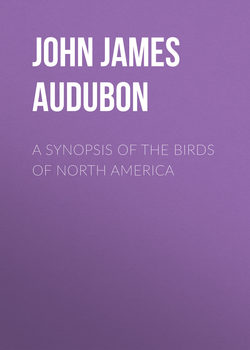Читать книгу A Synopsis of the Birds of North America - John James Audubon - Страница 78
FAMILY X. PARINÆ. TITS
ОглавлениеBill very short or of moderate length, straight, strong, compressed, rather sharp; both mandibles with the dorsal line sloping and slightly convex, the sides convex, the edges sharp; notches obsolete. Nostrils basal, roundish, concealed by the feathers. Head rather large, roundish; neck short; body short, and rather full. Feet of moderate length, rather stout; tarsus rather short, compressed, with eight distinct scutella; toes large, the three anterior united as far as the second joint, the hind toe much stronger and flattened beneath; claws rather long, stout, arched, much compressed, acute. Plumage very soft, blended, and full. Feathers at the base of the bill directed forwards. Wings of moderate length, much rounded, with the first quill very small, the fourth and fifth longest. Tail rather long, slender, of twelve narrow rounded feathers. Tongue emarginate and papillate at the base, abrupt at the tip, with four bristles. Œsophagus narrow, without dilatation; proventriculus oblong; stomach a rather strong oblong gizzard, with the muscles distinct, the epithelium dense, thin, longitudinally rugous; intestine short, of moderate width; cœca very small; cloaca oblong. Trachea simple, with four pairs of inferior laryngeal muscles.
GENUS I. PARUS, Linn. TIT
Bill short, stout; upper mandible with the dorsal line slightly decurved toward the end, the edges overlapping, with a slight lobe or festoon near the base, destitute of notch, rather acute; lower mandible with the dorsal outline slightly convex, the edges direct, the tip rather acute. Nostrils roundish, covered by bristly feathers. Head rather large, roundish; neck short. Feet proportionally large; tarsus of moderate length; hind toe very large and strong, the two lateral nearly equal, the outer adherent at the base; claws large, much compressed, very acute. Wings of moderate length, convex. Tail long, or of moderate length, rounded or graduated, of twelve rather narrow feathers.
125. 1. Parus bicolor, Linn. Tufted Titmouse. – Crested Titmouse. Great Chicadee
Plate XXXIX. Male and Female.
Bill very stout; feathers of the upper part of the head elongated into a crest; tail long, slightly rounded; upper parts leaden-blue, forehead black, lower parts greyish-white, the sides light red.
Male, 61/2, 9.
From Texas, where it breeds, to the Fur Countries, generally distributed eastward of the Rocky Mountains. Resident in the middle, southern, and western districts. Abundant.
Crested Titmouse, Parus bicolor, Wils. Amer. Orn. v. i. p. 187.
Parus bicolor, Bonap. Syn. p. 100.
Tufted Titmouse, Parus bicolor, Nutt. Man. v. i. p. 236.
Crested Titmouse, Parus bicolor, Aud. Orn. Biog. v. i. p. 199; v. v. p. 472.
126. 2. Parus atricapillus, Linn. Black-cap Tit. – Black-cap Titmouse, or Chicadee
Plate CCCLIII. Fig. 3. Male. Fig. 4. Female.
Bill moderately stout; tail long, emarginate, and rounded. Upper part of the head and hind neck, with a large patch on the fore neck, black; cheeks and sides of the neck white; back yellowish-grey; quills and tail-feathers dark greyish-brown, margined with bluish-white; the secondaries broadly edged with white; lower parts pale yellowish-red, the breast white.
Male, 51/8, 81/4.
From Maryland eastward and northward to Lat. 65°. In Kentucky during winter. Never in the southern parts.
Black-capt Titmouse, Parus atricapillus, Wils. Amer. Orn. v. i. p. 134.
Parus atricapillus, Bonap. Syn. p. 100.
Black-capt Titmouse, Nutt. Man. p. 241.
Black-capt Titmouse, Parus atricapillus, Aud. Orn. Biog. v. iv. p. 374.
127. 3. Parus Carolinensis, Aud. Carolina Tit
Plate CLX. Male and Female.
Bill very short, moderately stout; tail rather long, emarginate, and rounded. Upper part of the head and hind neck, with a large patch on the fore neck, black; cheeks and sides of the neck greyish-white; back yellowish-grey; quills and tail-feathers dark greyish-brown, margined with bluish-white, secondaries not conspicuously; lower parts greyish-white, tinged with yellow. This species is very similar to the last, but much inferior in size.
Male, 41/4, 6.
Breeds from Texas to New Jersey. Rather abundant. Resident.
Carolina Titmouse, Parus Carolinensis, Aud. Orn. Biog. v. ii. p. 341; v. v. p. 474.
128. 4. Parus Hudsonicus, Lath. Hudson's Bay Tit
Plate CXCIV. Male, Female, and Young.
Bill short, moderately stout; tail long, emarginate, and considerably rounded. Upper parts dull light brown, tinged with grey; fore neck black; cheeks and sides of the neck white; breast and abdomen white, sides light yellowish-brown.
Male, 5, 7.
Northern parts of Maine, during winter. Breeds from New Brunswick to Labrador and Hudson's Bay. Common. Migratory.
Parus Hudsonicus, Lath. Ind. Orn. v. ii. p. 566.
Hudson's Bay Titmouse, Aud. Orn. Biog. v. ii. p. 543.
129. 5. Parus rufescens, Towns. Chestnut-backed Tit
Plate CCCLIII. Fig. 1. Male. Fig. 2. Female.
Bill moderately stout; tail rather long, emarginate, scarcely rounded; upper part of head and hind neck dark brown, fore neck of a deeper tint of the same; cheeks and sides of neck white; back, rump, and sides of the body under the wings bright chestnut; the rest of the lower parts greyish-white.
Male, 41/2, wing, 23/8.
Columbia River. Abundant. Resident.
Parus rufescens, Chestnut-backed Titmouse, Towns. Journ. Acad. Nat. Sc. Philadelphia, v. vii. p. 190.
Chestnut-backed Titmouse, Parus rufescens, Aud. Orn. Biog. v. iv. p. 371.
130. 6. Parus minimus, Towns. Chestnut-crowned Tit
Plate CCCLIII. Fig. 5. Male. Fig. 6. Female.
Upper mandible with its outline more arched, the tip acute and considerably elongated; tail very long, emarginate, and much rounded; upper part of the head and hind neck pale brown; upper parts brownish-grey; wings and tail dusky, margined with greyish-white; cheeks of a paler tint than the head; all the lower parts brownish-white, the sides tinged with reddish.
Male, 41/2, wing, 110½/12.
Columbia River. Common. Migratory.
Parus minimus, Chestnut-crowned Titmouse, Towns. Journ. Acad. Nat. Sc. Philadelphia, v. vii. p. 190.
Chestnut-crowned Titmouse, Parus minimus, Aud. Orn. Biog. v. iv. p. 382.
